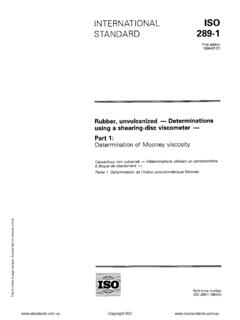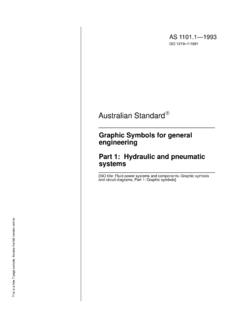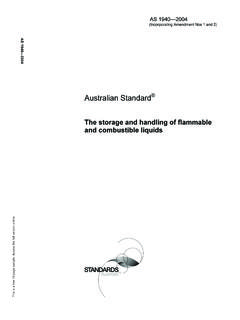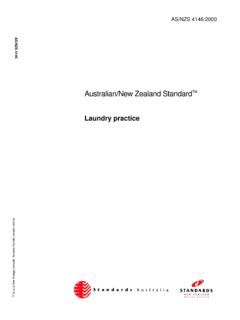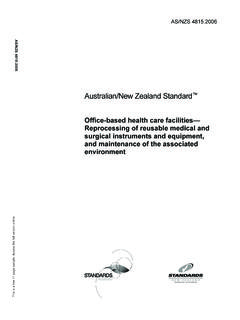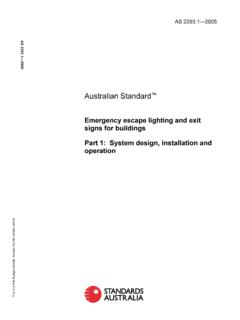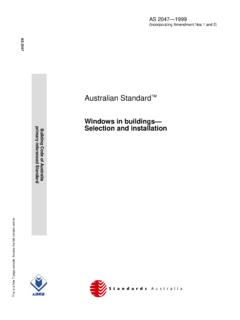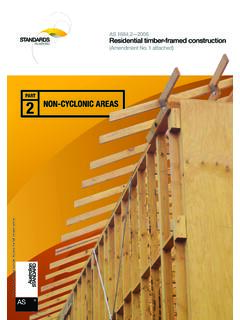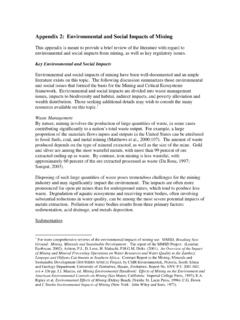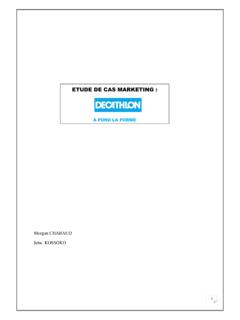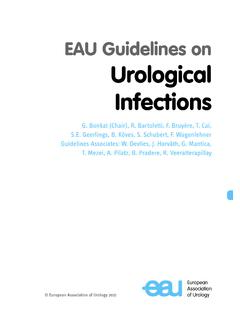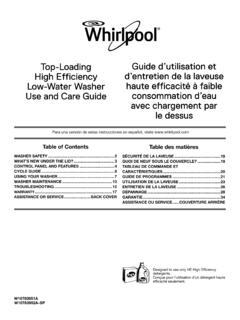Transcription of Australian/New Zealand Standard - SAI Global
1 AS/NZS 4020:2005 Australian/New Zealand Standard Testing of products for use in contact with drinking water AS/NZS 4020:2005 This is a free 7 page sample. Access the full version online. AS/NZS 4020:2005 This Joint Australian/New Zealand Standard was prepared by Joint Technical Committee CH-034, Materials in Contact with Drinking Water. It was approved on behalf of the Council of standards Australia on 20 October 2005 and on behalf of the Council of standards New Zealand on 4 November 2005. This Standard was published on 29 November 2005. The following are represented on Committee CH-034: AUSTRAP australian Chamber of Commerce and Industry australian Electrical and Electronic Manufacturers Association australian Industry Group australian Paint Manufacturers Federation australian Society for Microbiology Incorporated Certification Bodies (Australia) Copper Development Centre of Australia Health Department of Western Australia Ministry of Health, New Zealand National Health and Medical Research Council Plastics New Zealand Plastics Industry Pipe Association of Australia Rubber Manufacturers Association of Australasia The Royal australian Chemical Institute Water Services Association of Australia Keeping standards up-to-date standards are living documents which reflect progress in science, technology and systems.
2 To maintain their currency, all standards are periodically reviewed, and new editions are published. Between editions, amendments may be issued. standards may also be withdrawn. It is important that readers assure themselves they are using a current Standard , which should include any amendments which may have been published since the Standard was purchased. Detailed information about joint Australian/New Zealand standards can be found by visiting the standards Web Shop at or standards New Zealand web site at and looking up the relevant Standard in the on-line catalogue. Alternatively, both organizations publish an annual printed Catalogue with full details of all current standards . For more frequent listings or notification of revisions, amendments and withdrawals, standards Australia and standards New Zealand offer a number of update options.
3 For information about these services, users should contact their respective national standards organization. We also welcome suggestions for improvement in our standards , and especially encourage readers to notify us immediately of any apparent inaccuracies or ambiguities. Please address your comments to the Chief Executive of either standards Australia or standards New Zealand at the address shown on the back cover. This Standard was issued in draft form for comment as DR 05089. This is a free 7 page sample. Access the full version online. AS/NZS 4020:2005 Australian/New Zealand Standard Testing of products for use in contact with drinking water Originated as AS 3855(Int) 1991. Previous edition AS/NZS 4020:2002.
4 Fifth edition 2005. COPYRIGHT standards Australia/ standards New Zealand All rights are reserved. No part of this work may be reproduced or copied in any form or byany means, electronic or mechanical, including photocopying, without the writtenpermission of the publisher. Jointly published by standards Australia, GPO Box 476, Sydney, NSW 2001 and StandardsNew Zealand , Private Bag 2439, Wellington 6020 ISBN 0 7337 6993 4 This is a free 7 page sample. Access the full version 4020:2005 2 PREFACE This Standard was prepared by the Joint standards Australia/ standards New Zealand Committee CH-034, Materials in Contact with Drinking Water, to supersede AS/NZS 4020:2002, Testing of products for use in contact with drinking water.
5 In preparing this Standard , consideration has been given to comparable overseas standards , to minimize duplication of effort and to maintain commonality, wherever reasonable, with those standards . Particular consideration has been given to the various parts of BS 6920, Suitability of non-metallic products for use in contact with water intended for human consumption with regard to their effect on the quality of the water. Several of the test procedures and criteria given in BS 6920 have been adopted or modified for australian and New Zealand requirements. This Standard departs from BS 6920 as follows: (a) This Standard provides a method of testing for the leaching of compounds that may produce a mutagenic effect. (b) The requirement for products to be tested at surface area-to-volume ratios that are not less than those in the intended end-use exposure (with the exception of the test for growth of aquatic micro-organisms).
6 Where there is a difference between test and end-use exposures, provision is made for a scaling factor to be applied to the test result. (c) The inclusion of testing for metals extracted from metal products that are often components of products in contact with drinking water. Significant changes from the previous edition include the following: (i) Inclusion of a colorimetric method for determination of cytotoxic activity. (ii) Inclusion of an appendix on the structure of test reports. (iii) Revision of the appendix on product submission information. (iv) Altered requirements for testing non-metallic products for leaching of metals. The terms normative and informative have been used in this Standard to define the application of the appendices to which they apply.
7 A normative appendix is an integral part of a Standard , whereas an informative appendix is for information and guidance only. This is a free 7 page sample. Access the full version online. 3 AS/NZS 4020:2005 3 CONTENTS Page 4 1 2 REFERENCED 5 3 6 4 TEST 8 5 SCALING 9 6 TEST 11 7 HOT WATER 14 APPENDICES A SAMPLE 15 B SCALING FACTORS DERIVATION AND 21 C TEST METHOD TASTE OF WATER EXTRACT .. 26 D TEST METHOD APPEARANCE OF WATER 32 E TEST METHOD GROWTH OF AQUATIC 35 F TEST METHOD CYTOTOXIC ACTIVITY OF WATER 42 G TEST METHOD MUTAGENIC ACTIVITY OF WATER 51 H TEST METHOD EXTRACTION OF 55 I TEST METHOD EXTRACTION PROCEDURES FOR END-OF-LINE FITTINGS.
8 59 J HIGH TEMPERATURE TESTS .. 64 K TEST METHOD SAMPLE EXTRACTION PROCEDURE FOR USE WITH WATER-HEATING 66 L PRODUCT SUBMISSION 71 M SIMULATED 74 N TEST REPORT .. 76 This is a free 7 page sample. Access the full version 4020:2005 4 FOREWORD Guidelines for drinking water quality in Australia have been prepared conjointly by the National Health and Medical Research Council (NHMRC) and the australian Water Resources Council (AWRC), which combined in 1993 with the Agricultural Council and the Soil Conservation Council to form the Agriculture and Resource Management Council of Australia and New Zealand (ARMCANZ). In New Zealand , drinking water quality is subject to the Drinking Water standards for New Zealand prepared by the Ministry of Health.
9 The australian Drinking Water Guidelines (ADWG) and Drinking Water standards for New Zealand (DWSNZ) cover a range of physical, chemical, microbiological and radiological characteristics relevant to the health and aesthetic concerns of consumers, and recommend values for those characteristics. One of the important factors influencing the quality of water supplied to consumers is the effect of the various materials that come into contact with the water as it passes through the system. The potential effect becomes more critical as the size of the system decreases from water supply to reticulation to plumbing systems, and the residence time in contact with these systems increases. This Standard provides a means to test such materials in order that the achievement of the appropriate national recommended water quality values is not jeopardized.
10 The Standard prescribes methods of testing and compliance limits for the effects of a product on the taste and appearance of water, the ability of a product to support the growth of aquatic micro-organisms and the quantity of toxic metals and non-metallic substances leached from the product when exposed to the test water. In addition, the Standard prescribes extraction procedures for products in contact with hot water and in end-of-line situations. The hot water tests apply where water has the potential for human consumption, food preparation, utensil washing and oral hygiene. Not all of the physical and chemical characteristics listed in the NHMRC/ARMCANZ guidelines and the DWSNZ are specifically referred to in this Standard .
